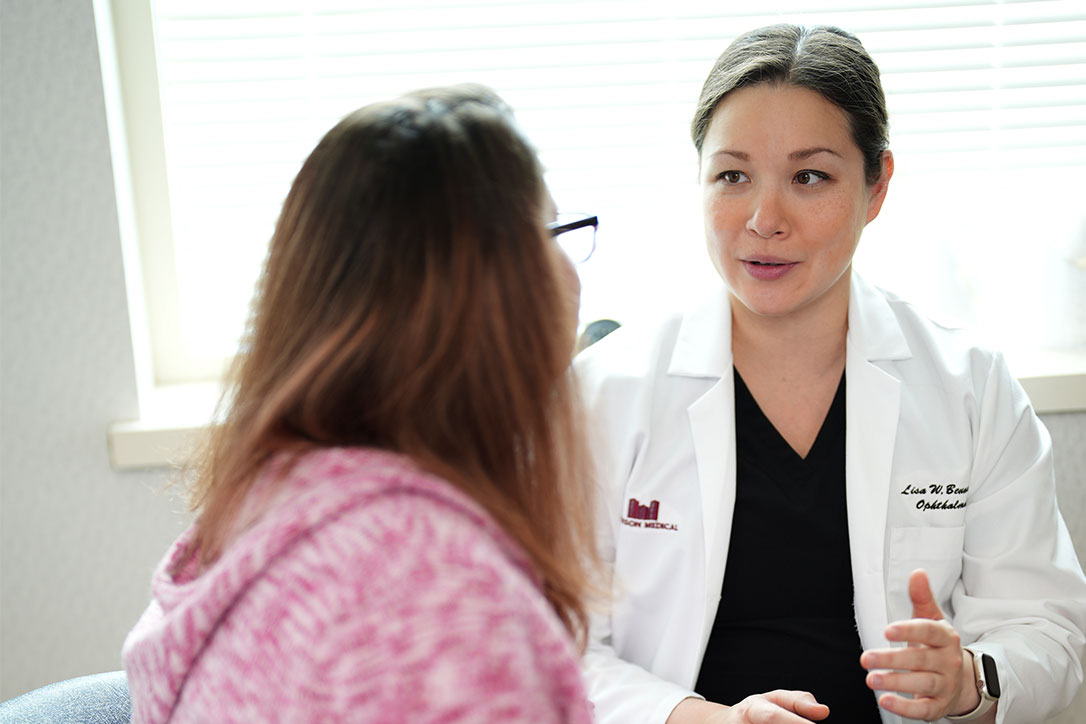A comprehensive eye examination is not just a quick check of your prescription. When you have an eye examination at Madison Medical Eye Care, you can be assured that not only will your glasses or contact prescription be updated, but your vision and overall eye health will be thoroughly evaluated. We check for glaucoma by measuring your eye pressure and viewing the optic nerve in the back of your eyes. Our experienced eye care professionals know which eye problems are associated with your medications and underlying medical issues and thoroughly evaluate them to provide the best possible care.
We provide blade-free LASIK, small incision cataract surgery, premium lens implants for cataract surgery, glaucoma treatment, diabetic eye care, dry eye treatment, macular degeneration treatment, contact lens fitting, comprehensive eye examinations and more.
WHAT TO EXPECT WHEN YOU VISIT
A comprehensive eye examination is not just a quick check of your prescription. When you have an eye examination at Madison Medical Eye Care, you can be assured that not only will your glasses or contact prescription be updated, but your eyes will be dilated to thoroughly examine the retina and blood vessels in the eye.


ABOUT OUR SERVICES
Cataract surgery today is a quick and painless procedure, taking less than 20 minutes. The procedure is done as an outpatient in either a hospital or surgical center. Cataract surgery at Madison Medical Eye Care is generally done without the need for shots around the eye, stitches, or patches afterward. While the procedure gets quicker and safer all the time, the newest advancements in cataract surgery involve the types of implants inserted at the time of surgery.
During cataract surgery, the natural lens is liquefied with a tiny ultrasound machine and removed with gentle suction. We then insert a small plastic implant to restore your vision. Without an implant, you would require thick glasses or contact lenses after surgery in order to see clearly, as was the case in the past. We have long been able to correct distance vision with these implants using a Standard implant, but now can correct for astigmatism with Toric implants and even for reading with Multi-focal implants.
Which implant is right for you depends on your eyes and your visual needs:
- If you don't like wearing glasses, then you are an ideal candidate for Multi-focal implants. They allow you to see close-up for reading, far-away for driving, and intermediate for computers. They give you the best all-around vision without glasses after cataract surgery. These lenses are now available whether or not you have astigmatism.
- If you do have considerable astigmatism, meaning that the surface of your eyes is curved like a football, then the use of a Toric implant could improve your distance vision without glasses after surgery. You would still need glasses for reading but may be able to get by with drug store readers.
- Standard, Toric, or Multi-focal lens implants - which is right for you? We will help you make this important decision at the time of your cataract consultation. Remember you only have cataract surgery once so you want to consider your choices carefully.
WHAT EXACTLY IS A CATARACT?
A cataract is a clouding of your natural lens, located behind your pupil. The lens contains protein that degenerates with age. When you are about 45 years old, this change in the lens protein makes the natural lens firmer and that's why reading glasses are needed at that time. Later, the lens protein begins to change color which makes the lens cloudy. The result is a cataract and blurred vision.
HOW CAN I TELL IF I HAVE A CATARACT?
You can't really tell if you have a cataract without a complete examination by an ophthalmologist or optometrist. The symptoms of a cataract are a gradual blurring of your vision, mainly for distance, and problems seeing at night due to glare or halos around lights. But blurred vision can have many causes, thus the need for the examination. Cataracts usually develop slowly so any rapid change in vision, for instance overnight, is probably due to a more serious problem and requires immediate attention.
WHAT IS CATARACT SURGERY LIKE?
Cataract surgery is an outpatient procedure that usually takes about 10 or 15 minutes. You are at the surgical facility for 3 or 4 hours, however, to prepare for the surgery and recover. Be sure to arrange for a ride home afterward because we do use mild IV sedation.
Once in the operating room, you lie on your back and look at a bright light during the procedure. Generally, no shots, stitches, or patches are required. You are relaxed but can hear everything that is going on during the procedure. Our doctors will explain what is happening and where you are supposed to look. It is important that you not move or talk during the procedure - keep looking at the light. Cataract surgery is not generally painful during the procedure or afterward.
After the surgery, your vision is a bit blurry but improves over the next several hours. There is generally no patch over the eye. You can do just about anything except drive for the rest of the day, but might feel more comfortable just going home and relaxing. The use of eye drops needed after surgery will be explained to you along with your restrictions, which include not lifting anything over 30 pounds, pushing on the eye, or swimming for two weeks after surgery.
WHAT HAPPENS, STEP BY STEP, IF I DECIDE TO HAVE CATARACT SURGERY?
Once we determine that you do have a cataract, our doctors will thoroughly explain the procedure and discuss your options for lens implants. Then our surgical coordinator will find a date for your surgery and a time for you to return to be measured for the lens implant. Your post-operative appointments will also be arranged. You will be asked to call your primary care doctor to schedule a pre-operative history and physical examination.
When you return for the lens measurements, which takes about an hour, we will give you a kit containing eye drops and explain how they are to be used. On the day of surgery, you will be asked to change into a hospital gown. You may leave your undergarments on. An IV will be started and you will be placed on a gurney. Most of our surgery takes place at Columbia-St. Mary's Hospital in Mequon which is the only location offering cataract surgery in Ozaukee County.
Once in the operating room, you will be given a mild sedative through the IV line. You will lie on your back and concentrate on looking at the bright light in front of you. We ask you not to talk or move unless you are experiencing pain or feel like you need to cough. Should any of these things occur, you let us know without moving much and we take care of the problem. You are in the operating room about 30 minutes and the procedure takes about 10 to 15 minutes.
Afterward, you return to your family or waiting friends in your private room in Day Surgery. You will be able to go home in 30 to 45 minutes after the surgery.
STANDARD, MULTI-FOCAL, TORIC IMPLANTS - WHICH ONE IS BEST?
Your choice of implant at the time of cataract surgery depends on your eyes and how you feel about glasses. You only have cataract surgery once in each eye so this decision will affect the way you see for the rest of your life. Even if you have not minded glasses in the past, you should at least imagine the possibility of not being so dependent on them after surgery with the use of Multi-focal or Toric implants. While there are three types of implants: Standard, Multi-focal, and Toric, not everyone is a candidate for them. We will be sure to discuss your implant options at the time of your cataract consultation.
The Standard Implant Option
If you love bifocal glasses, then stay with the Standard implant. But even if you haven’t really minded glasses in the past, you have to admit that they get in the way, cost money, and require that you look down to read. Furthermore, using a computer with bifocals can lead to neck pain. So just because you have always had glasses, doesn't mean you shouldn't at least consider the other options.
The Multi-Focal Implant Option
The Multi-focal implants allow you to see well far away for driving, near for reading, and at intermediate distances for computers or countertop activities after surgery without glasses. With these implants, you could play golf with over-the-counter sunglasses and keep score without looking for reading glasses. While we don’t guarantee that you would never use glasses with these implants, it would be rare. This freedom from glasses makes your life simpler and really “turns back the clock” to a time when you did not need glasses. We have many patients who are actually now wanting their cataracts to worsen so they can take advantage of these Multi-focal implants! They turn something that is potentially negative, a cataract, into something positive: relative freedom from glasses.
The Toric Implant Option
If youhave astigmatism or a curved shape to the front of your eyes, you could take advantage of the Toric implants. They compensate for your astigmatism so you have great distance vision without glasses after surgery. You would still need glasses to read but could probably get by with over-the-counter reading glasses. You would no longer have to hassle with thick bifocal glasses and make sure they were adjusted just right to see well.
Refractive lens exchange (RLE), also known as clear lens extraction (CLE), is a surgical procedure for vision correction that replaces the natural lens of the eye with an intraocular lens, or IOL. Using the same surgical techniques as cataract surgery, the clear lens of the eye is removed and replaced with an IOL to change the focusing power of the eye.
An alternative to laser vision correction, the RLE procedure avoids the need for a corneal modification that is used during the LASIK procedure, and instead uses the same procedures performed in cataract surgery.
Patients who choose to undergo refractive lens exchange have several options when it comes to the type of IOL that will be implanted into the eye. The RLE procedure uses the same IOLs used in cataract surgery and is able to treat all types of visual disorders, including farsightedness, nearsightedness, presbyopia and astigmatism. Patients are provided with a choice of the most advanced premium IOLs which will allow them to see clearly at all distances.
Candidates For Refractive Lens Exchange
Refractive lens exchange is ideal for patients who:
- Want to reduce or eliminate their dependence on glasses or contact lenses
- Are between the ages of 45 and 75 years of age
- Have myopia (nearsightedness), hyperopia (farsightedness), and/or presbyopia (need for reading glasses) but no significant cataracts
- Are poor candidates for LASIK or PRK due to extreme glasses prescription or thin cornea
- Have no health issues that affect the eyes
Benefits Of A Refractive Lens Exchange
A refractive lens exchange is an alternative to those patients with corneas that are too thin for a laser vision correction procedure.
Some of the advantages of RLE include the following:
- The rapid recovery of vision
- The cornea remains untouched
- There is no need for cataract surgery in the future
- Vision is now stable
- Correction of presbyopia at the same time
Benefits Of A Refractive Lens Exchange
The refractive lens exchange procedure is performed on an outpatient basis using the same techniques as those for cataract surgery.
A topical or local anesthesia is applied to the eyes to minimize discomfort during the procedure. Through a tiny incision of 3mm or less, the natural lens of the eye is removed and replaced with an IOL that is inserted through the same opening. Once inserted, the lens is unfolded and moved into its permanent position in the eye. There are no stitches needed as the incision will be able to seal on its own. The refractive lens exchange procedure takes just 20 minutes to perform and offers patients significant and immediate results.
After The Refractive Lens Exchange Procedure
After a refractive lens exchange, patients can return home the same day, and can return to work and other regular activities after a day or two. Many report immediate improvements to their vision, and vision will continue to improve as the brain adapts to the new lens. Once vision has stabilized, it will likely stay the same over time as the lenses correct vision and prevent the patient from developing cataracts in the future. The second eye is usually treated a few weeks after the first procedure.
The extent of the results of the RLE will depend upon the patients eyes, lifestyle and the IOL selected for the procedure. Many patients are able to eliminate their dependence on glasses or contacts after this procedure, while others may still need glasses for driving or reading.
Risks And Complications Of A Refractive Lens Exchange
All surgery carries some degree of risk. These concerns should be discussed, in detail, with the surgeon.
The risks and complications of a refractive lens exchange are the same as those of cataract surgery and may include:
- Retinal detachment
- Increased pressure in the eye
- Infection
- Bleeding
- Ptosis (droopy eyelid)
- Sensitivity to light
- Dry eyes
- Glaucoma
- Distortion in vision
Contact lenses are a great alternative to glasses but they must be properly fit and their care understood to be safely worn. Unlike glasses, contact lenses come in different shapes so must be seen on the eye by the doctor to be sure they are not too tight or loose. Also the prescription for contacts is not the same as that for glasses so must be assessed with the contacts on. Poorly fit contacts and improper care can lead to severe infections and scarring of the eyes that may affect vision for years to come.
Below you will find the answers to some of the most frequently asked questions regarding contact lenses.
What is "new" in contact lenses?
Contact lenses improve all the time so if you have had problems with them in the past you may want to try them again every few years. The trend now is to disposable contacts that are worn daily for 2 weeks to a month and then discarded. The advantage of this type of contact is that there is less of a chance for protein build-up so the comfort and vision is improved.
There are contact lenses for those with astigmatism called “Toric” contacts. We offer colored contacts for those who want a new look. There are bifocal contacts or mono-vision contacts for those over 45 years-old who want to be able to see far away and close up without glasses.
Are my contacts "fit?"
We are often asked at the end of an eye exam for a contact lens prescription, which is not the same as a glasses prescription. Contacts come in different materials, sizes and shapes, as well as powers. An improperly fit contact lens can lead to serious eye problems such as a corneal abrasion or even a corneal ulcer. A contact lens fitting is not usually included in an eye examination fee, due to the extra testing involved, but can be done at the time of a regular eye exam. Our contact lens specialist, Dr. Mark German, makes sure that your contacts are "fit."
What is involved in a contact lens fitting? The cornea is like a window in the front part of your eye. Each individual cornea is unique, much like a fingerprint for that person. When fitting contact lenses, we take several measurements from the cornea to determine the appropriate size and the curvature for the contact lens along with the glasses prescription. Many different plastics are available in contact lenses and one is chosen to provide you with the best possible comfort and vision. A contact lens material, design, power and shape is chosen at the time of the fitting and that contact lens is placed on the eye. The contact lens is then checked with a microscope to ensure that the lens is fitting properly and the vision is assessed. If a contact lens is not fitted correctly, or if a patient tries to wear someone else’s contact lenses, eye irritation or even a serious eye injury can occur.
The next part of the contact lens fitting involves education. You could have the perfect contacts but if you are not caring for them correctly you could still get into serious trouble. The wearing schedule and cleaning regimen needs to be understood. For those new to contacts, learning how to put them in and take them out may take some time. You want to leave that appointment seeing well, understanding how to care for your contacts and realizing the warnings signs of trouble that would necessitate an immediate appointment.
What kinds of solutions should I use?
With the advent of more advanced solutions for disposable contact lenses, we are now faced with the question of ‘do we or do we not rub’ our contact lenses to clean the protein and germs off of them. When using ‘no rub’ solutions properly, after removing a contact lens at the end of the day, each lens needs to be squirted with the solution for 10 seconds on each side to remove debris and germs. As this takes a significant amount of solution, an alternative is to ‘rub’ the contacts for about 10 seconds with your fingers with the same solution. Either way, the contacts are then stored in a clean case that you rinsed in the morning and allowed to air dry. Also, replace the solution in the case at the end of every day.
Recently, the eye health industry has been faced with several outbreaks of vision threatening infections that have been traced back to some of these solutions. After thorough investigation, the finding is that some of these infections have occurred because the individuals were not cleaning their contact lenses properly. They were either not rubbing their lenses or were not rinsing them sufficiently. Some patients were just removing their contacts and placing them in the contact lens case. So whichever method you choose, "no-rub" or "rub", do it properly.
What can happen if your contact lenses are not cleaned properly? A corneal ulcer may result which is not only painful but sight threatening. So, take a little extra time to avoid getting into trouble with your contacts. And certainly do not sleep or swim in your contacts!
Can I develop an allergy to my contact lenses?
While it sounds like quite a mouthful, giant papillary conjunctivitis (GPC) is a common eye condition. It's actually an allergy to contact lenses. It generally occurs in patients who have worn contact lenses for years. They come in concerned that their contacts are no longer comfortable and that they have a slight discharge from their eyes. "But I've worn contacts for years without problems" is their response when told of the diagnosis. It's precisely that long duration of wear that triggers the condition.
Patients with asthma, hay fever or animal allergies may be at greater risk of developing GPC. This condition is believed to be a reaction to protein deposits building up on the contact lenses. The name comes from what we see when we flip the upper eyelid: 1-2 mm bumps called "giant papillae."
The key to treatment is decreased lens wear time, frequent replacement of the contacts and diligent cleaning of the lenses each day. Disposable contacts help because they are discarded before the protein builds up. Sleeping in contacts has to stop. Besides the above, treatments may include allergy drops or non-steroidal anti-inflammatory drops. Once the GPC clears up, the patient may want to consider LASIK vision correction to avoid a recurrence.
How should I care for my contact lenses?
Contact lenses are a safe and effective way to correct your vision BUT you need to be sure you are taking care of them correctly. Poor contact lens care can lead to severe infections and scarring that could permanently impair your vision.
There are many different types of contact lenses so be sure you know how long you should wear your particular type. It varies from one day to until they are uncomfortable. With rare exceptions, you should not sleep in your contacts lenses. This is because your eyes become deprived of oxygen during the night when a contact is in. The result may be an inability to fight off an infection.
Besides not sleeping in your contacts, you also should not wear them from the minute you wake up until bedtime that night. This also is to let the cornea, the front part of the eye, breath and stay healthy. You should wear your glasses at least 1-2 hours per day.
Care products vary depending on the type of contact lens. Be sure you clean your contacts daily and replace the solution in the case each day. The contact lens case should be air dried after a thorough rinsing each day.
If your eyes are uncomfortable, take the contacts out. Let your eyes rest but if the discomfort does not improve, you need to be seen. Everyone who wears contacts needs a pair of glasses also for situations like this.
What if I have dry eyes?
While worse in the winter, dry eyes can make contact lens wear uncomfortable all year long. The symptoms of dry eyes are usually worse towards the end of the day. Many also notice fluctuating vision and redness around the iris (colored portion of the eye). Their contacts may even curl around the edges when they remove them.
The problem is due to a decrease in tear production over time and a more rapid evaporation of the tear film in dry environments. The result is a drying out of many types of soft contact lenses. But if you have been experiencing any of these problems, we may have a solution for you.
Recent technology has produced a new type of soft contact lens to prevent dry eye symptoms with contacts. These silicone soft contact lenses are designed to be healthier for the cornea (the front surface of the eye) and lessen the dryness problem.
Some of the contact lens options are: Acuvue Advance, Oasys, O2Optics, Focus Night and Day, and Purevision lenses. There are even options for those of you with astigmatism or who are wearing bifocal contacts.
Other contact lens option, other treatments for dry eye include the placement of tiny punctual plugs which decrease the drainage of tears from the eyes, the use of tear supplements and prescription products such as Restasis that increase the quality of your tears. If you have dry eyes you may have to admit that contact lenses are not for you. The contacts make your eyes more dry by absorbing your tears, leaving less moisture to coat the eye. Many patients consider LASIK vision correction when this occurs.
Can I swim in contact lenses?
Can’t see without your glasses and love your contacts, so why not swim in them? The answer is that you should NOT swim in contact lenses because it increases your risk of eye problems from mild irritation to severe eye infections. Most contact lenses are at least 50% water. So if you are swimming in a pool with chlorine, that chlorinated water is going to penetrate your contacts and stay in contact with the surface of your eye for up to an hour after swimming. This can irritate the surface of your eye and increase your risk of infection.
While mild eye irritation goes away in a day or so, a severe eye infection can result in permanent eye damage. Even in the best maintained pool or spa, bacteria can be present. In lake water, a severe pathogen called acanthamoeba may be present that causes a difficult to treat corneal ulcer. This protozoa penetrates the cornea rapidly and often requires specially formulated eye drops to save the eye. Beaches may also present the possibility of a fusarium fungal infection.
So if you want to swim and see without glasses, please consider LASIK. Wearing contact lenses in the water decreases your chance of fighting off possible infections. Should you have a severe corneal ulcer, the scarring may make contact lens wear in the future impossible and also make you a poor candidate for LASIK vision correction.
What exactly is "blade-free" LASIK?
Our doctors is proud to have been exclusively offering blade-free LASIK since 2005. Blade-free LASIK uses two lasers instead of one to perform your LASIK procedure. First the brand new Alcon WaveLight FS200 laser generates the small flap on the surface of your eye with tiny air bubbles. This pain-free procedure takes about 10 seconds per eye. It is a major advancement over the older metal microkeratome, still used at many low cost laser centers, and assures that the flap is perfect each and every time. The Alcon WaveLight EX500 Excimer laser is then used to contour the shape of your eye to improve your vision. This laser is also pain-free and usually takes less than a minute per eye. Together they provide an integrated laser system that is the fastest available in the U.S.
The lasers are not just faster, they are also more precise. The improvement in vision, especially for those with more extreme prescriptions, is even better than before. They also open up LASIK to many who may not have been candidates in the past because they can treat the widest range of prescriptions of any laser available.
Patients love the improved comfort and potential to see even better than they did with glasses or contacts before surgery. I appreciate the precise automation with the smallest laser spot size in the industry and fastest eye tracking system available: 20 times faster than natural eye movements! I’ve gained many more options for individualizing LASIK for a particular patient and you’ve gained an improved outlook on life.
When considering LASIK, the technology employed is a very important factor. You only have the procedure once so you want it done right the first time. Most low cost LASIK centers have not made the investments necessary to upgrade to the all-laser technology. A frequent call to our clinic starts out with "How much is LASIK" but that is not the point. The main consideration should be how happy you will be with your vision for years to come.
The computer guided WaveLight FS200 laser is 100% more accurate than the metal blade and is currently the best possible way to prepare for the second part of the procedure, shaping the surface of your eye to improve your vision. The many advantages of this laser to make the flap include improved safety, better vision, reduced dry eye symptoms, higher predictability and precision, personalized flap, reduced night glare and halos, and allowing more patients to qualify for LASIK.
What happens during the LASIK procedure?
Below are a number of videos explaining what will happen during your LASIK procedure so you will be well prepared on your big day! Be sure you have a driver on the day of the procedure and have cleared you schedule for that day and the day after - meaning you should take two days off of your regular activities for the procedure and recovery. You would have been in for your pre-operative evaluation 1-2 weeks before the procedure when we did extra testing and used long acting dilating drops that affect your near vision for up to 12 hours. For that appointment, you would have been out of your soft contacts (if you wear them) for a week or 1 month if you wore hard or gas permeable contacts.
STEP 1: Once you arrive at the LASIK center, you are given a Valium pill to relax you and your care after the procedure is thoroughly explained to you. You then enter the LASIK suite and your eyes are marked for the correction orientation. This is done because your eyes rotate slightly when you lay down. You then lay down on the bed and are rotated to the left under the first laser, the FS200. The next step is that a small cone is brought down gently on the surface of the eye while you look into the dark tunnel. There is a slight pressure sensation but no pain.
STEP 2: The laser then sends tiny air bubbles into your cornea at 120 microns below the surface to make the corneal flap. This cool laser is painless and takes less than 10 seconds to make a perfectly centered corneal flap. We do the right eye first and then the left.
STEP 3: You are then rotated to the center again and the area around your eyes cleaned. The second laser, the EX500, has already been programmed with your exact treatment plan to contour the shape of your cornea to provide a customized approach to clear vision. Again, we do the right eye first and then the left.
STEP 4: Once under the second laser, the EX500, the corneal flap of the right eye is gently lifted and the laser used to improve your outlook on life! You look at the green light during the cool laser treatment which lasts less than a minute and is also pain-free. The flap is then gently re-positioned and dried in place for a minute and a half.
STEP 5: We then do the same thing with the left eye. Before you know it the whole process is over and you are ready to go home for your nap. When you sit up from the laser your vision is much better than before without glasses but still slightly blurred, like looking through dirty glasses. When you wake up from your nap it is better again. The next morning you should be about 90% healed but still may be slightly blurry. Most patients can drive themselves to their appointment that day but healing varies so it is a good idea to have a back-up driver to get you to your appointment the day after the procedure.
What type of lasers do you use?
We exclusively utilize blade-free LASIK with the Alcon WaveLight FS200 laser for generating the flap and the Alcon WaveLight Ex500 laser for the reshaping your cornea. Together they provide an integrated laser system that is the fastest available in the U.S.
The main advantage of the blade-free laser system over the older microkeratome blade is safety: It is almost impossible to have a complication in surgery when making the flap with the laser. The laser places tiny bubbles at the precise depth set by our doctors and takes only 21 second pain-free seconds per eye. With direct visualization by our doctor, you are assured that the flap is centered over the pupil each and every time. The older microkeratome is a blind pass over the cornea, possibly resulting in off-center or irregular flaps and permanently blurred vision. Another advantage of the laser generated flap is the customization for the individual patients by precisely controlling the thickness of the flap. The result is that many who were told in the past they were not a candidate for LASIK can now benefit from this remarkable procedure.
The Alcon WaveLight EX500 has the fastest eye tracking system available today-- it is 20 times faster than natural eye movements! This advanced laser is updated frequently as new technology becomes available. The lasers are not just faster, they are also more precise. The improvement in vision, especially for those with more extreme prescriptions, is even better than before. They also open up LASIK to many who may not have been candidates in the past because they can treat the widest range of prescriptions of any laser available.
The pairing of the Alcon WaveLight ES200 and EX500 lasers assures you that you are having the safest and most precise refractive procedure available-- right here in Milwaukee.
How much recovery time do I need?
Usually we recommend that you take 2 days off your usual routine for LASIK vision correction. On the day of the procedure you are lightly sedated and going home for a protracted nap is helpful to speed your recovery. That means that you definitely need to take the day of the procedure off. On the day after many patients see very well but others take a bit more time to heal so it is just safer to keep that day free also.
We generally schedule LASIK procedures on Thursdays so typically patients who do not work weekends have the extra buffer of the weekend to recover. It is, however, acceptable to return to work 2 days after your LASIK procedure.
You also need to arrange for a ride to the LASIK center on the day of your procedure and have a back-up driver for the day after in case you do not feel confident driving to your appointment with us that day.
Am I a good candidate for LASIK?
There is no way to tell over the phone if a patient is a good candidate for LASIK vision correction. We really have to see you and examine your eyes. That is the purpose of the free screening exam. The exam starts with you viewing an educational video about iLASIK. We than evaluate your distance prescription, the size of your pupils, the stability of your glasses prescription, the curvature of the surface or your eyes and your corneal thickness. Once these factors have been measured by an ophthalmic technician, you are seen by Dr. Martha Jay who evaluates the information and examines your eye
s.In order to be a good candidate for LASIK, your glasses prescription should not have changed significantly over the last 1-2 years. Your eyes must be otherwise healthy. You should be at least 18 years-old, although it is rare to have a stable glasses prescription before age 21. Your cornea cannot be too thick or too thin. Your pupils cannot be too large. You must have a glasses prescription that is within the limits of the procedure.
Can I get LASIK if I have diabetes, glaucoma, or am pregnant?
Yes, you can have LASIK if you have diabetes or glaucoma but these conditions must be under good control. Part of the reason for the thorough pre-operative eye examination we do is to be sure that your eyes are not affected by other medical or eye conditions. Should you have diabetic eye problems such as bleeding or swelling in the back of the eye, these conditions would have to be treated first and be stable before considering LASIK.
If you have glaucoma but it is under good control, LASIK may still be an option. If the condition is severe with loss of vision, however, LASIK would not be encouraged.
If you are pregnant or nursing, you want to wait at least 2-3 months after delivery or discontinuing nursing to consider LASIK as your prescription may be altered temporarily by the hormonal changes. You can still come in for a screening but we would wait for the actual procedure until that time.
WHICH PHYSICIAN IS RIGHT FOR YOU?
For LASIK Vision Correction
Dr. Lisa Bennett has years of experience in LASIK Vision Correction
For Cataract Surgery
Dr. Lisa Bennett and Dr. Joseph Zilisch are trained to perform cataract surgery
For Contact Lens Fitting
Visit our Optometrists, Dr. James Ivanoski or Dr. Alwin Edakkunnathu for a corrective lens fitting
For General Eye Care
Dr. Lisa Bennett, Dr. Joseph Zilisch, Dr. Alwin Edakkunnathu, and Dr. James Ivanoski provide comprehensive eye and vision care




